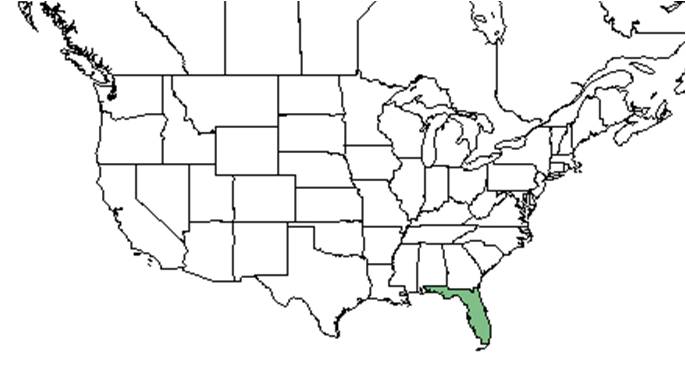Difference between revisions of "Garberia heterophylla"
(→Description) |
|||
| Line 17: | Line 17: | ||
| range_map_caption = Natural range of ''Garberia heterophylla'' from USDA NRCS [http://www.plants.usda.gov Plants Database]. | | range_map_caption = Natural range of ''Garberia heterophylla'' from USDA NRCS [http://www.plants.usda.gov Plants Database]. | ||
}} | }} | ||
| + | |||
| + | Common name: garberia | ||
==Description== | ==Description== | ||
<!-- Basic life history facts such as annual/perrenial, monoecious/dioecious, root morphology, seed type, etc. --> | <!-- Basic life history facts such as annual/perrenial, monoecious/dioecious, root morphology, seed type, etc. --> | ||
| − | |||
==Distribution== | ==Distribution== | ||
| Line 29: | Line 30: | ||
===Fire ecology=== <!--Fire tolerance, fire dependence, adaptive fire responses--> | ===Fire ecology=== <!--Fire tolerance, fire dependence, adaptive fire responses--> | ||
===Pollination=== | ===Pollination=== | ||
| − | + | The following Hymenoptera families and species were observed visiting flowers of ''Garberia heterophylla'' at Archbold Biological Station (Deyrup 2015): | |
| − | |||
| − | |||
| − | |||
| − | |||
| − | |||
| − | |||
| − | |||
| − | |||
| − | |||
| − | |||
| − | |||
| − | |||
| − | |||
| − | |||
| − | |||
| − | |||
| − | |||
| − | |||
| − | |||
| − | |||
| − | |||
| − | |||
| − | |||
| − | |||
| − | |||
| − | |||
| − | |||
| − | |||
| − | |||
| − | |||
| − | |||
| − | |||
| − | |||
| − | |||
| − | |||
| − | |||
| − | + | Apidae: ''Bombus impatiens, Epeolus carolinus'' | |
| − | + | Colletidae: ''Colletes mandibularis'' | |
| − | + | Halictidae: ''Agapostemon splendens, Augochlora pura, Augochlorella aurata, Augochloropsis metallica, Lasioglossum miniatulus, L. nymphalis, L. placidensis, Sphecodes heraclei'' | |
| − | + | Megachilidae: ''Anthidiellum notatum rufomaculatum, Coelioxys sayi, Megachile albitarsis, M. mendica, M. pruina, M. xylocopoides'' | |
| − | + | Sphecidae: ''Cerceris flavofasciata floridensis, Eremnophila aureonotata'' | |
| − | Vespidae: Zethus spinipes | + | Vespidae: ''Monobia quadridens, Pachodynerus erynnis, Stenodynerus fundatiformis, Zethus slossonae, Zethus spinipes'' |
===Use by animals=== <!--Herbivory, granivory, insect hosting, etc.--> | ===Use by animals=== <!--Herbivory, granivory, insect hosting, etc.--> | ||
| Line 85: | Line 50: | ||
==Photo Gallery== | ==Photo Gallery== | ||
==References and notes== | ==References and notes== | ||
| + | Deyrup, M.A. and N.D. 2015. Database of observations of Hymenoptera visitations to flowers of plants on Archbold Biological Station, Florida, USA. | ||
Revision as of 15:36, 6 August 2015
| Garberia heterophylla | |
|---|---|
Error creating thumbnail: Unable to save thumbnail to destination
| |
| Scientific classification | |
| Kingdom: | Plantae |
| Division: | Magnoliophyta - Flowering plants |
| Class: | Magnoliopsida - Dicotyledons |
| Order: | Asterales |
| Family: | Asteraceae ⁄ Compositae |
| Genus: | Garberia |
| Species: | G. heterophylla |
| Binomial name | |
| Garberia heterophylla (W. Bartram) Merr. & F. Harper | |

| |
| Natural range of Garberia heterophylla from USDA NRCS Plants Database. | |
Common name: garberia
Contents
Description
Distribution
Ecology
Habitat
Phenology
Seed dispersal
Seed bank and germination
Fire ecology
Pollination
The following Hymenoptera families and species were observed visiting flowers of Garberia heterophylla at Archbold Biological Station (Deyrup 2015):
Apidae: Bombus impatiens, Epeolus carolinus
Colletidae: Colletes mandibularis
Halictidae: Agapostemon splendens, Augochlora pura, Augochlorella aurata, Augochloropsis metallica, Lasioglossum miniatulus, L. nymphalis, L. placidensis, Sphecodes heraclei
Megachilidae: Anthidiellum notatum rufomaculatum, Coelioxys sayi, Megachile albitarsis, M. mendica, M. pruina, M. xylocopoides
Sphecidae: Cerceris flavofasciata floridensis, Eremnophila aureonotata
Vespidae: Monobia quadridens, Pachodynerus erynnis, Stenodynerus fundatiformis, Zethus slossonae, Zethus spinipes
Use by animals
Diseases and parasites
Conservation and Management
Cultivation and restoration
Photo Gallery
References and notes
Deyrup, M.A. and N.D. 2015. Database of observations of Hymenoptera visitations to flowers of plants on Archbold Biological Station, Florida, USA.